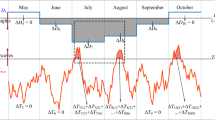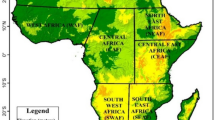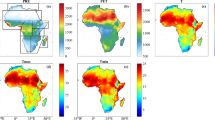Abstract
In this study, likely changes in extreme temperatures (including 16 indices) over China in response to global warming throughout the twenty-first century are investigated through the PRECIS regional climate modeling system. The PRECIS experiment is conducted at a spatial resolution of 25 km and is driven by a perturbed-physics ensemble to reflect spatial variations and model uncertainties. Simulations of present climate (1961–1990) are compared with observations to validate the model performance in reproducing historical climate over China. Results indicate that the PRECIS demonstrates reasonable skills in reproducing the spatial patterns of observed extreme temperatures over the most regions of China, especially in the east. Nevertheless, the PRECIS shows a relatively poor performance in simulating the spatial patterns of extreme temperatures in the western mountainous regions, where its driving GCM exhibits more uncertainties due to lack of insufficient observations and results in more errors in climate downscaling. Future spatio-temporal changes of extreme temperature indices are then analyzed for three successive periods (i.e., 2020s, 2050s and 2080s). The projected changes in extreme temperatures by PRECIS are well consistent with the results of the major global climate models in both spatial and temporal patterns. Furthermore, the PRECIS demonstrates a distinct superiority in providing more detailed spatial information of extreme indices. In general, all extreme indices show similar changes in spatial pattern: large changes are projected in the north while small changes are projected in the south. In contrast, the temporal patterns for all indices vary differently over future periods: the warm indices, such as SU, TR, WSDI, TX90p, TN90p and GSL are likely to increase, while the cold indices, such as ID, FD, CSDI, TX10p and TN10p, are likely to decrease with time in response to global warming. Nevertheless, the magnitudes of changes in all indices tend to decrease gradually with time, indicating the projected warming will begin to slow down in the late of this century. In addition, the projected range of changes for all indices would become larger with time, suggesting more uncertainties would be involved in long-term climate projections.















Similar content being viewed by others
References
Ahmed SM (2014) Assessment of irrigation system sustainability using the Theil–Sen estimator of slope of time series. Sustainability Sci 9:293–302
Alexander LV, Zhang X, Peterson TC, Caesar J, Gleason B, Klein Tank AMG, Haylock M, Collins D, Trewin B, Rahimzadeh F (2006) Global observed changes in daily climate extremes of temperature and precipitation. J Geophys Res Atmos 111:1042–1063
Araghi A, Mousavi-Baygi M, Adamowski J (2016) Detection of trends in days with extreme temperatures in Iran from 1961 to 2010. Theor Appl Climatol 125:213–225
Beharry SL, Clarke RM, Kumarsingh K (2015) Variations in extreme temperature and precipitation for a Caribbean island: Trinidad. Theor Appl Climatol 122:783–797
Beniston M, Stephenson DB, Christensen OB, C.A.T. Ferro, Frei C, Goyette S, Halsnaes K, Holt T, Jylhä K, Koffi B (2007) Future extreme events in European climate: an exploration of regional climate model projections. Clim Change 81:71–95
Bian T, Ren G, Zhang B, Zhang L, Yue Y (2015) Urbanization effect on long-term trends of extreme temperature indices at Shijiazhuang station, North China. Theor Appl Climatol 119:407–418
Buontempo C, Mathison C, Jones R, Williams K, Wang C, Mcsweeney C (2014) An ensemble climate projection for Africa. Clim Dyn 44:1–22
Busuioc A, Chen D, Hellström C (2001) Performance of statistical downscaling models in GCM validation and regional climate change estimates: application for Swedish precipitation. Int J Climatol 21:557–578
Cardil A, Molina DM, Kobziar LN (2014) Extreme temperature days and their potential impacts on southern. Eur Nat Hazards Earth Syst Sci 14:3005–3014
Cheng L, Phillips TJ, Aghakouchak A (2015) Non-stationary return levels of CMIP5 multi-model temperature extremes. Clim Dyn 44:2947–2963
Choi G, Collins D, Ren G, Trewin B, Baldi M, Fukuda Y, Afzaal M, Pianmana T, Gomboluudev P, Huong PTT (2009) Changes in means and extreme events of temperature and precipitation in the Asia-Pacific Network region, 1955–2007. Int J Climatol 29:1906–1925
Collins M, Booth BBB, Harris GR, Murphy JM, Sexton DMH, Webb MJ (2006) Towards quantifying uncertainty in transient climate change. Clim Dyn 27:127–147
Déqué M (2007) Frequency of precipitation and temperature extremes over France in an anthropogenic scenario: model results and statistical correction according to observed values. Global Planetary Change 57:16–26
Diaz JH (2007) The influence of global warming on natural disasters and their public health outcomes. Am J Disaster Med 2:33–42
Etterson JR, Shaw RG (2001) Constraint to adaptive evolution in response to global warming. Science 294:151–154
Filahi S, Tanarhte M, Mouhir L, Morhit ME, Tramblay Y (2016) Trends in indices of daily temperature and precipitations extremes in Morocco. Theor Appl Climatol 124:959–972
Fioravanti G, Piervitali E, Desiato F (2016) Recent changes of temperature extremes over Italy: an index-based analysis. Theor Appl Climatol 123:473–486
Fonseca D, Carvalho MJ, Marta-Almeida M, Melo-Gonçalves P, Rocha A (2015) Recent trends of extreme temperature indices for the Iberian Peninsula. Phys Chem Earth Parts A/b/c 94:66–76
Grotjahn R, Black R, Leung R, Wehner MF, Barlow M, Bosilovich M, Gershunov A, Gutowski WJ, Gyakum JR, Katz RW (2016) North American extreme temperature events and related large scale meteorological patterns: a review of statistical methods, dynamics, modeling, and trends. Clim Dyn 46:1151–1184
Guan Y, Zheng F, Zhang X, Wang B (2015) Trends and variability of daily precipitation and extremes during 1960–2012 in the Yangtze River Basin, China. Glob Planet Change 124:79–94
Hamed KH, Rao AR (1998) A modified Mann-Kendall trend test for autocorrelated data. J Hydrol 204:182–196
Hartmann CLADL, Brönnimann S, Dentener FJ, Dlugokencky EJ, Easterling DR, Kaplan A, Soden BJ (2014) IPCC (2013), Climate Change 2013, in The Physical Science Basis, Working Group I Contribution to the Fifth Assessment Report of the Intergovernmental Panel on Climate Change, WMO/UNEP, Cambridge
Iqbal MA, Penas A, Canoortiz A, Kersebaum KC, Herrero L, Del Río S (2016) Analysis of recent changes in maximum and minimum temperatures in Pakistan. Atmos Res 168:234–249
Jiang C, Mu X, Wang F, Zhao G (2015) Analysis of extreme temperature events in the Qinling Mountains and surrounding area during 1960–2012. Quatern Int 392:129–138
Karim MR, Rahman MA (2015) Drought risk management for increased cereal production in Asian Least Developed Countries. Weather Clim Extremes 3:24–35
Khan U, Valeo C (2016) Short-term peak flow rate prediction and flood risk assessment using fuzzy linear regression. J Environ Inform 28:71–89
Kim YH, Min SK, Zhang X, Zwiers F, Alexander LV, Donat MG, Tung YS (2015) Attribution of extreme temperature changes during 1951–2010. Clim Dyn 46:1769–1782
Kitoh A, Endo H (2016) Changes in precipitation extremes projected by a 20-km mesh global atmospheric model. Weather Clim Extremes 11:41–52
Liang K, Peng B, Li J, Liu C (2014) Variability of temperature extremes in the Yellow River basin during 1961–2011. Quatern Int 336:52–64
Lü J, Ju J, Ren J, Gan W (2012) The influence of the Madden-Julian Oscillation activity anomalies on Yunnan’s extreme drought of 2009–2010. Sci China Earth Sci 55:98–112
Mahmood R, Babel MS (2014) Future changes in extreme temperature events using the statistical downscaling model (SDSM) in the trans-boundary region of the Jhelum river basin. Weather Clim Extremes s 5–6:56–66
Mahmood R, Babel MS, Jia S (2015) Assessment of temporal and spatial changes of future climate in the Jhelum river basin, Pakistan and India. Weather Clim Extremes 4:40–55
Marengo JA, Jones R, Alves LM, Valverde MC (2009) Future change of temperature and precipitation extremes in South America as derived from the PRECIS regional climate modeling system. Int J Climatol 29:2241–2255
Mason SJ, Waylen PR, Mimmack GM, Rajaratnam B, Harrison JM (1999) Changes in extreme rainfall events in South Africa. Clim Change 41:249–257
Mcsweeney CF, Jones RG, Booth BBB (2012) Selecting ensemble members to provide regional climate change information. J Clim 25:7100–7121
Meinshausen M, Meinshausen N, Hare W, Raper SCB, Frieler K, Knutti R, Frame DJ, Allen MR (2009) Greenhouse-gas emission targets for limiting global warming to 2|[thinsp]||[deg]|C. Nature 458:1158–1162
Moriasi DN, Arnold JG, Van Liew MW, Bingner RL, Harmel RD, Veith TL (2007) Model evaluation guidelines for systematic quantification of accuracy in watershed simulations. Trans Asabe 50:885–900
Murphy JM, Sexton DM, Barnett DN, Jones GS, Webb MJ, Collins M, Stainforth DA (2004) Quantification of modelling uncertainties in a large ensemble of climate change simulations. Nature 430:768–772
Murphy JM, Sexton DMH, Jenkins GJ, Boorman PM, Booth BBB, Brown CC, Clark RT, Collins M, Harris GR, Kendon EJ (2009) UK climate projections science report: climate change projections
Noguer M, Jones RG, Hassell DC, Hudson DA, Wilson SS, Jenkins GJ, Mitchell JFB (2003) Workbook on generating high resolution climate change scenarios using PRECIS
Panthou G, Vischel T, Lebel T, Blanchet J, Quantin G, Ali A (2012) Extreme rainfall in West Africa: a regional modeling. Water Resour Res 48:682–688
Pepler AS, Díaz LB, Prodhomme C, Doblas-Reyes FJ, Kumar A (2015) The ability of a multi-model seasonal forecasting ensemble to forecast the frequency of warm, cold and wet extremes. Weather Clim Extremes 7:68–77
Programme UCI (2009) UK climate projections (UKCP09)
Qin N, Wang J, Yang G, Chen X, Liang H, Zhang J (2015) Spatial and temporal variations of extreme precipitation and temperature events for the Southwest China in 1960–2009. Geoenviron Disasters 2:1–14
Qiu J (2010) China drought highlights future climate threats. Nature 465:142–143
Root TL, Price JT, Hall KR, Schneider SH, Rosenzweig C, Pounds JA (2003) Fingerprints of global warming on wild animals and plants. Nature 421:57–60
Salmi T, Määttä A, Anttila P, Ruoho-Airola T, Amnell T, Salmi T, Määttä A, Amnell T (2002) Detecting Trends of Annual Values of Atmospheric Pollutants by the Mann-Kendall Test and Sen’s Solpe Estimates the Excel Template Application MAKESENS. Universitas Gadjah Mada 31
Sang YF, Wang Z, Liu C (2014) Comparison of the MK test and EMD method for trend identification in hydrological time series. J Hydrol 510:293–298
Schoof JT, Robeson SM (2015) Projecting changes in regional temperature and precipitation extremes in the United States. Weather Clim Extremes 11:28–40
Sun W, Mu X, Song X, Wu D, Cheng A, Qiu B (2016) Changes in extreme temperature and precipitation events in the Loess Plateau (China) during 1960–2013 under global warming. Atmos Res 168:33–48
Timbal B, Jones DA (2008) Future projections of winter rainfall in southeast Australia using a statistical downscaling technique. Clim Change 86:165–187
Torma C, Giorgi F, Coppola E (2015) Added value of regional climate modeling over areas characterized by complex terrain—precipitation over the Alps. J Geophys Res Atmos 120:3957–3972
Wang X, Huang G, Lin Q, Nie X, Cheng G, Fan Y, Li Z, Yao Y, Suo M (2013) A stepwise cluster analysis approach for downscaled climate projection—a Canadian case study. Environ Model Softw 49:141–151
Wang X, Huang G, Liu J (2014) Projected increases in near-surface air temperature over Ontario, Canada: a regional climate modeling approach. Clim Dyn 45:1381–1393
Wang X, Huang G, Lin Q, Nie X, Liu J (2015a) High-resolution temperature and precipitation projections over Ontario, Canada: a coupled dynamical-statistical approach. Q J R Meteorolog Soc 141:469–472
Wang X, G. Huang J, Liu, Z. Li, Zhao S (2015b) Ensemble Projections of regional climatic changes over Ontario, Canada. J Clim 28:7327–7346
Wang L, Wu Z, Wang F, Du H, Zong S (2016) Comparative analysis of the extreme temperature event change over Northeast China and Hokkaido, Japan from 1951 to 2011. Theor Appl Climatol 124:1–10
Yu E, Sun J, Chen H, Xiang W (2014) Evaluation of a high-resolution historical simulation over China: climatology and extremes. Clim Dyn 45:1–19
Zhang Q, Li J, David Chen Y, Chen X (2011) Observed changes of temperature extremes during 1960–2005 in China: natural or human-induced variations? Theor Appl Climatol 106:417–431
Zhang Q, Xiao M, Singh VP, Wang Y (2016a) Spatiotemporal variations of temperature and precipitation extremes in the Poyang Lake basin, China. Theor Appl Climatol 124:855–864
Zhang S, Tao F, Zhang Z (2016b) Changes in extreme temperatures and their impacts on rice yields in southern China from 1981 to 2009. Field Crops Res 189:43–50
Zhang Y, Huang G, Wang X, Liu Z (2017) Observed changes in temperature extremes for the Beijing–Tianjin–Hebei region of China. Meteorol Appl 24:74–83
Zhou B, Wen QH, Xu Y, Song L, Zhang X (2014) Projected changes in temperature and precipitation extremes in China by the CMIP5 multimodel ensembles. J Clim 27:6591–6611
Acknowledgements
This research was supported by the National Key Research and Development Plan (2016YFA0601502, 2016YFC0502800 and 2016YFE0102400), Fundamental Research Funds for the Central Universities (2017MS049), Natural Sciences Foundation (51190095, 51225904), the Program for Innovative Research Team in University (IRT1127), the 111 Project (B14008), the National Basic Research Program (2013CB430401), Ontario Ministry of the Environment and Climate Change, and the Natural Science and Engineering Research Council of Canada.
Author information
Authors and Affiliations
Corresponding authors
Rights and permissions
About this article
Cite this article
Guo, J., Huang, G., Wang, X. et al. Dynamically-downscaled projections of changes in temperature extremes over China. Clim Dyn 50, 1045–1066 (2018). https://doi.org/10.1007/s00382-017-3660-7
Received:
Accepted:
Published:
Issue Date:
DOI: https://doi.org/10.1007/s00382-017-3660-7




